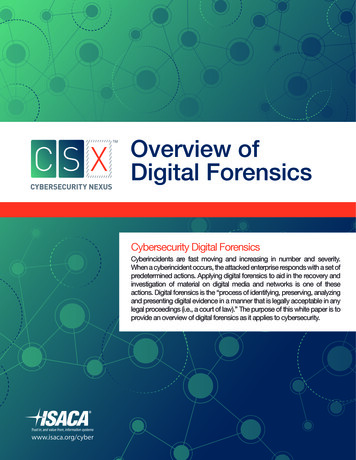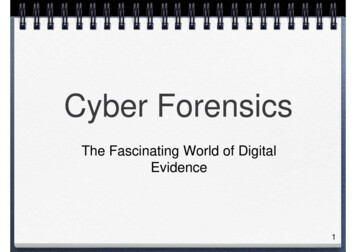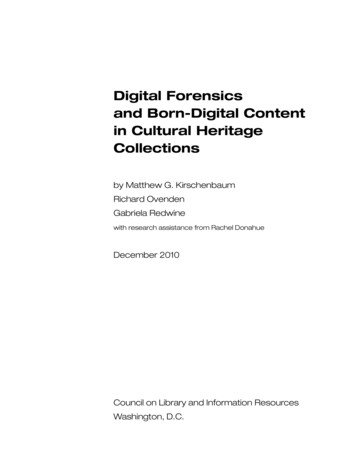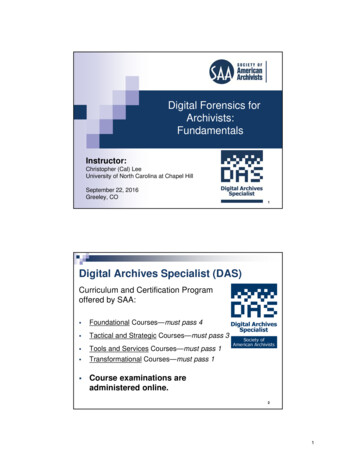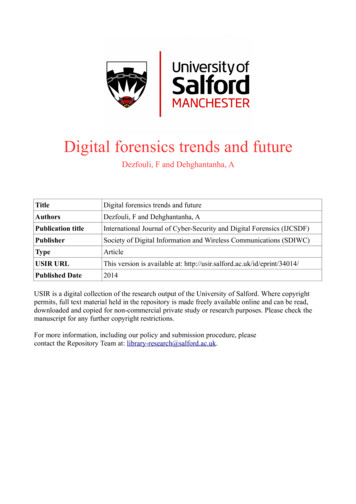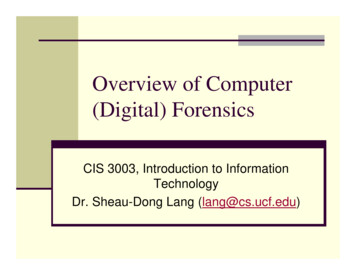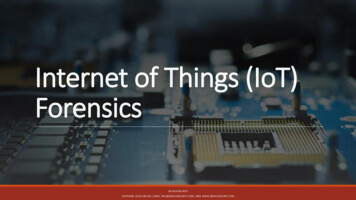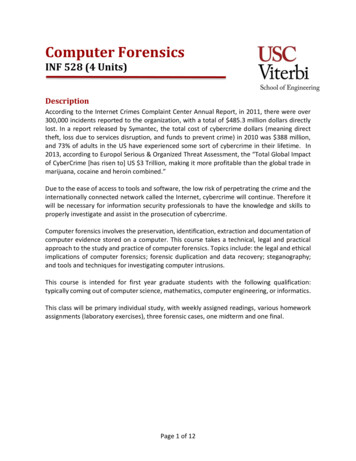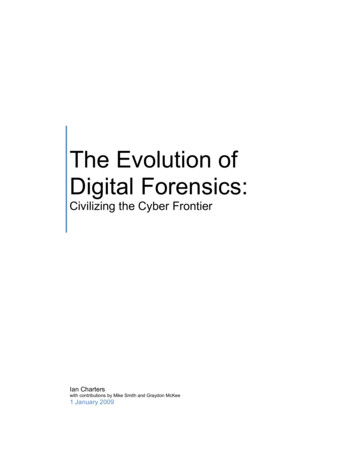
Transcription
The Evolution ofDigital Forensics:Civilizing the Cyber FrontierIan Charterswith contributions by Mike Smith and Graydon McKee1 January 2009
The Evolution of Digital ForensicsPage 2 This page left intentionally blank This work is licensed under the Creative Commons Attribution-No Derivative Works 3.0 Unported License. To view a copy of this license, / or send a letter to Creative Commons, 171 Second Street, Suite 300, San Francisco, California, 94105, USA.
The Evolution of Digital ForensicsPage 3Table of ContentsLicense . 3Introduction. 5Phase 1: The Ad Hoc Phase . 5Phase 2: The Structured Phase . 7Phase 3: The Enterprise Phase . 12The Future . 17Summary . 18End Notes . 20About the Author. 21LicenseThis work is licensed under the Creative Commons Attribution-No Derivative Works 3.0Unported License.To view a copy of this license, visit http://creativecommons.org/licenses/by-nd/3.0/ or send aletter to Creative Commons, 171 Second Street, Suite 300, San Francisco, California, 94105,USA.This work is licensed under the Creative Commons Attribution-No Derivative Works 3.0 Unported License. To view a copy of this license, / or send a letter to Creative Commons, 171 Second Street, Suite 300, San Francisco, California, 94105, USA.
The Evolution of Digital ForensicsPage 4 This page left intentionally blank This work is licensed under the Creative Commons Attribution-No Derivative Works 3.0 Unported License. To view a copy of this license, / or send a letter to Creative Commons, 171 Second Street, Suite 300, San Francisco, California, 94105, USA.
The Evolution of Digital ForensicsPage 5IntroductionThis document is based on a paper that I wrote and delivered at NIST‟s Techno Forensics 2008Conference, on 27 October, 2008 8.html).That paper was called, Digital Forensics: The “No Escape” Zone.Some time ago I was thinking about the evolution of various aspects of computer security. Oneof the ideas that occurred to me was that by looking at the way forensics evolved in the past,with an eye to the pressures that guided its evolution, we could get a better understanding ofhow forensics would evolve in the near future.So, I decided to apply this idea to my experiences in the arena of computer forensics. The wayI see it, computer forensics has undergone three stages of evolution:1. The Ad Hoc Phase2. The Structured Phase3. The Enterprise PhasePhase 1: The Ad Hoc PhaseThe Ad Hoc phase was characterized by a lack of structure, a lack of clear goals, and a lack ofadequate tools, processes and procedures. This first phase can almost be called the preforensics or proto-forensics period. In application, the greatest weakness most organizationsdid not understand the importance of an Acceptable Use policy and procedures.At this time it was not uncommon to see an organization‟s management carefully collectevidence that IT equipment was being used “inappropriately” by an individual, only to find thatHR and Corporate Counsel would refuse to act citing the lack of a published appropriate usepolicy.Moreover, these policies needed to be backed up by a set of well conceived and coordinatedprocedures. These procedures needed to contain information concerning what actions couldand should be taken if “inappropriate” use was reported or suspected. Both elements, policyand procedure are critical to being able to enforce sanctions against an individual(s) caughtusing IT equipment inappropriately. I‟ve seen many cases in which the evidence ofinappropriate use was clearly in violation of a well written, published and distributed policy. Thelack of established procedures however drove Corporate Counsel into apoplexy over the issueof due process.Just when things couldn‟t get worse, the way that evidence was collected and handled began tobe challenged in court cases involving inappropriate use. This was a two-pronged attack. Thefirst challenged the accuracy of the forensic tools and the second focused on procedural orThis work is licensed under the Creative Commons Attribution-No Derivative Works 3.0 Unported License. To view a copy of this license, / or send a letter to Creative Commons, 171 Second Street, Suite 300, San Francisco, California, 94105, USA.
The Evolution of Digital ForensicsPage 6chain-of-custody issues. Could it be proved that the tools captured the data accurately? Howcan you prove that the evidence is accurate and untampered with if the floppy containing thedata was left to sit in an unsecured desk drawer? Imagine being sued by the an employee whowas terminated for surfing porn on company equipment during company time and losing thecase because your poor processes and procedures provided their attorney the opportunity toargue that their rights had been violated. If this sounds unbelievable then let me assure youthat it has in fact happened on many an occasion.The most unfortunate thing about the Ad Hoc Phase is that we had to live through it twice. Thefirst time occurred during the time of the mainframe and centralized computing. It happenedagain during the microprocessor age with the proliferation of workstations. Within thecentralized model of the mainframe era, information was segregated to a single location. It wasrelatively easy to physically secure the system and therefore limit access to the informationcontained therein. As we moved away from the use of centralized computing resources towardthe distributed model that we enjoy today the issues of appropriate use, data security, and dataintegrity have become more pronounced. With the acceptance of this model all of the hardlearned lessons learned of the past with regard to the need for digital forensics policy, process,This work is licensed under the Creative Commons Attribution-No Derivative Works 3.0 Unported License. To view a copy of this license, / or send a letter to Creative Commons, 171 Second Street, Suite 300, San Francisco, California, 94105, USA.
The Evolution of Digital ForensicsPage 7procedures and tools were largely forgotten. Ironically, the microprocessor also provided thetool to make computer hacking, and abuse more accessible and wide-spread.Some speculate that quantum computing is the next major stage in computing. If that is thecase, let‟s just hope that we do not have to relive the Ad Hoc Phase yet again.All of this turmoil created the pressure for the move to the second stage of evolution in digitalforensics; the Structured Phase.Phase 2: The Structured PhaseThe Structured Phase evolved out of the confusion surrounding the use of digital forensics.Questions concerning appropriate use, the surveillance of employees and potential intruders,the need for policy and procedure alignment and various legal issues lead to a period in which agreat deal of structure was imposed upon the practice of digital forensics. This structure wasexpressed in three primary areas. Policy-based programsDefined and coordinated processes closely aligned with PolicyRequirement for forensically sound toolsIt has often been said that armies always prepare for the last war. The truth behind this is thatthe experiences of the last war are the freshest and most salient. In this respect, it isn‟tuncommon for security program managers to be caught in the same thought process asgenerals and admirals. Both sets of decision makers are trying to create effective responses tothreats, both are facing a mixture of known and unknown threats, both have limited resourcesfor the effort, and both operating in a real-time threat environment.So, in the structured phase of development of digital forensics tools and techniques, the mostsignificant developments focused on creating effective responses to the difficult problems facedin the Ad Hoc stage of development.So, let‟s start our examination of this phase by looking at the enabling criminal legislation (andjust to keep things simple we will only be looking at legislation at the Federal level). Thefollowing statutes are usually cited as the core cybercrime statutes: 18 U.S.C. § 1029. Fraud and Related Activity in Connection with Access DevicesoWas intended to criminalize hacking systems while using a model; it also included hacking viaremote terminals 18 U.S.C. § 1030. Fraud and Related Activity in Connection with ComputersThis work is licensed under the Creative Commons Attribution-No Derivative Works 3.0 Unported License. To view a copy of this license, / or send a letter to Creative Commons, 171 Second Street, Suite 300, San Francisco, California, 94105, USA.
The Evolution of Digital Forensicso Page 8Was intended to criminalize hacking systems via direct access (i.e. the insider threat)18 U.S.C. § 1362. Communication Lines, Stations, or SystemsoWas intended to criminalize hacking a system via a telephone line and telecommunicationinfrastructure.o Closely related to the federal wire fraud statutes18 U.S.C. § 2510 et seq. Wire and Electronic Communications Interception and Interception of OralCommunicationsoImportant because it outlines what constitutes illegal bugging which is important if you monitoremployeesoSurprisingly this statute does not apply to law enforcement or intelligence authorities.oMost states have their own statutes that deal with bugging so they should be consulted becausethey vary considerably. The rule of thumb – if the transmission crosses state lines then the federalstatutes apply and the individual state statutes may also apply. 18 U.S.C. § 2701 et seq. Stored Wire and Electronic Communications and Transactional Records AccessoCovers the capture or intercept of “communication” including “data”, not just voice communicationsthat have been stored electronically. 18 U.S.C. § 3121 et seq. Recording of Dialing, Routing, Addressing, and Signaling InformationoClosely related to 18 U.S.C. § 2701 et seq.oFocuses on the capture of routing dataBasically, this legislation criminalizes hacking either on systems or over a wire. Moreover, itmakes hacking, data theft, and system disruption a Federal crime. However, this legislationalso generally requires that you be able to place a value on the act. That is to say that if youcannot demonstrate monetary loss or potential monetary loss associated with an act of hacking,data theft or system disruption, you may not have a crime. In the past this has led to some verycreative cost accounting.This work is licensed under the Creative Commons Attribution-No Derivative Works 3.0 Unported License. To view a copy of this license, / or send a letter to Creative Commons, 171 Second Street, Suite 300, San Francisco, California, 94105, USA.
The Evolution of Digital ForensicsPage 9I personally think equal consideration should also be given to various privacy statutes andintellectual property statues. Others would also suggest the importance of anti-spam, identitytheft, and data breach legislation -- however, I contend that state legislation is quickly acquiringprominence in these areas. Reviewing the state statutes is largely pointless due to the fact thateach month some state legislature passes some significant legislation on the topic. Maintainingcurrency on the topic requires almost full-time professional attention.Of course, none of this addresses some of the most contentious issues associated with,„appropriate use‟ policies such as the impact inappropriate use may have on other individualswithin the environment. Let us take look at an example of one employee surfing porn while atwork. If other employees become aware of this fact they may feel that they are working in ahostile work environment. This puts the company in a situation where it may be liable and thisleads us into the area of employment law and that again violates my scope rule.So, without trying to appear glib, you can quickly see that developing a clear understanding ofthe legal issues surrounding “appropriate use” is a complex undertaking. You must rely heavilyon your organizations legal counsel as they are experts in this area. Rely upon their guidanceand advice for help with both “appropriate use” policy as well as procedure. As important, butnot necessarily as obvious, similar guidance should also be sought with respect to developingand implementing appropriate processes and procedures to take in response to seeminglyexternally-based hacking of the network. Such policies can provide incident response teamswith the critical guidance they‟ll need in critical situations.The Structured Phase is also responsible for creating a forensic tool industry that is driven bythe need for tools that can withstand courtroom challenges as well as collecting data in aforensically correct manner. Since this is such an important concept, let‟s take a moment todefine what “forensically correct” means. I‟ve always believed that in order for data to becollected in a forensically correct manner it has to be:1.2.3.4.5.Collected and maintained in accordance with a defined procedureIt must be verifiable as authenticIt must be verified as relevantIt must be collected in a reliable mannerIt must preserve the original evidence to the extent possibleThese general rules also closely follow the guidelines established by the courts that I have dealtwith. However, the criteria may be different in your specific jurisdiction, so as always whendealing with legal matters, get professional local council.If you have not defined and documented your procedure you cannot reproduce it. If you can‟treproduce your procedure, its effectiveness and the authenticity of the data collected using theprocedure cannot be assessed. This is an important point because under the law eachThis work is licensed under the Creative Commons Attribution-No Derivative Works 3.0 Unported License. To view a copy of this license, / or send a letter to Creative Commons, 171 Second Street, Suite 300, San Francisco, California, 94105, USA.
The Evolution of Digital ForensicsPage 10individual accused of wrongdoing has a right to be treated fairly and equally. If differentprocesses are used to process each individual case, the individuals involved can rightly claimthat they were not treated equally and therefore not fairly. I believe procedures also addressissues such as chain-of-custody issues – that is to say, addressing how you can verify that thedata collected have not been tampered with.Authenticity is nothing more than being able to prove that the evidence or data is what it ispurported to be. This also can be addressed with procedural documentation, and can be part ofa chain-of-custody discussion. Hashing of data, such as employing an MD5 hash algorithm tomathematically define and verify a data set, is a great technique to verify that the collected dataand the analyzed data set are the same.Relevance means that the data must relate to the issue at hand.Reliability must pass the test of “beyond a reasonable doubt”. “Beyond a reasonable doubt” is alegal definition. Being convinced “beyond a reasonable doubt” means that you‟re convinced amajority of (theoretical) reasonable men. This is often a matter of documentation. So, forexample if a collection or data copying algorithm is subjected to expert review, and presumablyafter several iterations of review and revision is documented to be sound and correct, that bodyof documentation weighs heavily in court as to it reliability.Also a tool or technique must preserve the original evidence whenever possible. In part this iswhy when duplicating original disk, write blockers are employed. Write blockers insure that datais not added to the original drive in the copy process. Likewise it is common practice to work offof a copy of a copy of the original disk. This insures that if a mistake is made, you can simplymake another copy from the initial copy without harm.So, even though information security programs became policy based and spawned processesand procedures in alignment with these policies Phase 2 wasn‟t always effective. In part this isbecause the tools being developed and utilized were difficult to use and expensive to employ,that is to say that they didn‟t work well in real-world environments.Allow me to provide a few examples. The first situation can perhaps be described as not havingthe right tool for the right job. If you look at hardware-based keystroke recorders that weretypical of the first generation of tools, they were very obvious when installed. I think we can allagree employing one in most circumstances would lead the individual who the target of aninvestigation to conclude that they were either under investigation, or that a hacker wastargeting them. Even “modern” USB-based hardware keystroke loggers look pretty much likeold school keystroke loggers.This work is licensed under the Creative Commons Attribution-No Derivative Works 3.0 Unported License. To view a copy of this license, / or send a letter to Creative Commons, 171 Second Street, Suite 300, San Francisco, California, 94105, USA.
The Evolution of Digital ForensicsPage 11Figure 1: PS/2 Keystroke LoggerFigure 2: USB Keystroke LoggerThis work is licensed under the Creative Commons Attribution-No Derivative Works 3.0 Unported License. To view a copy of this license, / or send a letter to Creative Commons, 171 Second Street, Suite 300, San Francisco, California, 94105, USA.
The Evolution of Digital ForensicsPage 12The second situation is an even more typical, costly and alerting situation. That is the situationin which an organization agrees that there is sufficient cause to warrant an investigation of anindividual or group of individuals. The next day the individual or group comes to work anddiscovers that their computers have been removed from their workspace “for maintenance”. Infact, the equipment has all been hauled off to the lab for imaging and analysis because theportable imaging equipment that would allow in situ data collection of data is either unavailableor unaffordable1.This kind of thinking provided the impetus for the intellectual and technological development thatled to the third phase in the history of digital forensics.Phase 3: The Enterprise PhaseOnce the tools and techniques of digital forensics were accepted as legitimate and effective, themarket began to drive digital forensics from a point-based solution into an enterprise-basedsolution. This imposed some significant technical demands. It also created significant marketopportunities.In general, the Enterprise phase of digital forensics can be characterized by: Real-time collectionField collections tools tailored to the need of the collectorsForensics as a serviceReal-time collection requires a central location to store and analyze the data collected. Thisalso requires that the collection takes place over the wire or the network infrastructure.While real-time collection of data is preferred, some of the devices that contain data needingcollection reside on the network either directly or continuously. This requires that tools andtechniques be engineered to meet the real world requirements of field or in situ collection.These tools and techniques need to be discrete and should be employed in such a way as tonot alert the subject of the investigation that they are being investigated. In these cases speed,portability, accuracy, and a low-profile nature are important.1In situ and perhaps even after hours collection, provides the option of not alerting the subjectof an investigation – and all of their coworkers in the area -- that they are under investigation.This can be an especially useful option if the investigative subject is in fact innocent. It canavoid all of the embarrassment and ill-feeling associated publically investigating an innocentparty.This work is licensed under the Creative Commons Attribution-No Derivative Works 3.0 Unported License. To view a copy of this license, / or send a letter to Creative Commons, 171 Second Street, Suite 300, San Francisco, California, 94105, USA.
The Evolution of Digital ForensicsPage 13In some cases, the requirements of real-time data collection can be disruptive to the Enterpriseenvironment so consideration must be given to removing, or outsourcing forensic datacollection.So, let me give you a few examples of this evolution .Referring back to my previous example of a keystroke logger, in the Enterprise Phase twoprimarily solutions soon evolved for the desktop and the laptop. The first and least common isan embedded hardware keystroke logger. While these devices have to be installed beforecollection is considered, they can operate both on-line – that is to say while connected to theEnterprise infrastructure – or off-line. While connected to the network they can be activated,deactivated, and the data that they have collected can be downloaded, providing manycollection options, all of which are transparent to the user.Figure 3: Internal Desktop/Laptop Keystroke LoggerAnd despite the trade-offs between hardware and software keystroke loggers, Enterprise Phasesolutions are usually software-based and can also be centrally administered across the networkwithout the knowledge of the individual end-user. Usually, such solutions are part of a largermore comprehensive forensic solution. Let me take a moment to elaborate on the trade-offsbetween hardware and software based keystroke logging solutions. It is commonly believedThis work is licensed under the Creative Commons Attribution-No Derivative Works 3.0 Unported License. To view a copy of this license, / or send a letter to Creative Commons, 171 Second Street, Suite 300, San Francisco, California, 94105, USA.
The Evolution of Digital ForensicsPage 14that hardware based keystroke loggers, if properly implemented, are more accurate thansoftware-based solutions. Even the best software based keystroke loggers are known to dropdata under specific circumstances. On the other hand, software based solutions are seen asbeing much more flexible in that they can be installed and uninstalled over a networkconnection.Similar trends can be seen in the area of digital forensics support for mobile devices. Ad HocPhase solutions simply didn‟t exist and Structured Phase solutions were invariable tied to aforensics laboratory workstation. Enterprise Phase solutions offer in situ or on-site collectionopportunities. This is an obvious requirement given the nature of mobile devices. Again,nothing changes the nature of an investigation like showing up in the investigative subject‟soffice and seizing all of their computer equipment, media, phone and PDA so that it all can beimaged back in the lab. A perfect example is the Forensic Mini Digidrive Write-Blocked MemoryReader as seen at http://www.forensicpc.com/products.asp?cat 13. This device is an excellentexample of the reduction in form factor over past media copying solutions. Equipment like thisallows forensic data collection to move out of the lab and on-site. This trend is continuing andwe are seeing tools being developed that move forensic collection from the “mobile lab” to the“back-pack lab” or even the “messenger bag lab.”Figure 4: Portable Media Copier with Write-BlockerAnd where highly mobile solutions for media imaging have evolved, imaging solutions for mobiledevices have also kept pace. One of the real innovators in this field is Paraben. They haveproduced the Project-a-Phone device for collecting forensic data from mobile phones(http://www.projectaphone.com/). Prior to this a desktop or laptop computer was required forimaging a mobile phone. While this was effective, the size of these devices placed a burden onthe forensic collection team who was already burdened with many other data collection tools.Small, “low-drag” solutions like this are a blessing.This work is licensed under the Creative Commons Attribution-No Derivative Works 3.0 Unported License. To view a copy of this license, / or send a letter to Creative Commons, 171 Second Street, Suite 300, San Francisco, California, 94105, USA.
The Evolution of Digital ForensicsPage 15The ultimate in high-performance, low-drag imaging solutions for mobile devices may very wellbe Paraben‟s CSI Stick. http://www.csistick.com/. While the name of the product does make melaugh, it certainly creates an effective mental image of what the device is all about. The CSIStick is also an affordable solution. This is typical of the sort of capabilities and devices thatdefine the Enterprise Phase forensic evolution.Figure 5: Paraben Project-a-phoneFigure 6: Paraben CSI StickIn addition to the hardware based solutions, we have seen a similar evolution in software baseddigital forensic solutions. The following are some of the landmark software packages that havehelped define Enterprise Phase software-based solutions:This work is licensed under the Creative Commons Attribution-No Derivative Works 3.0 Unported License. To view a copy of this license, / or send a letter to Creative Commons, 171 Second Street, Suite 300, San Francisco, California, 94105, USA.
The Evolution of Digital Forensics Access Data – Known File Filter (KFF) National Drug Intelligence Center‟s - Hashkeeper Guidance Software – EnCase Enterprise Access Data – Enterprise Brian Carrier‟s – The Sleuth Kit (TSK) Mediant - Intelligent Response Clearwell – E-discovery Platform Athena Archiver LogLogicPage 16Known File Filter and Hashkeeper are key tools that have established the foundation for theautomation and standards-based forensic data collection and analysis. They incorporate ascientific, reproducible, and disciplined approach allowing the forensic professional to ignorelarge volumes of known system and application files so that attention can be focused onpotentially significant data and in the case of Hashkeeper, the development of know bad filesignatures.It was only recently that I understood the significance of the development of known “bad” filesignatures. A discussion with a friend and former FBI Special Agent alerted me to the fact thatthere is a range of illegal computer activity in which the perpetrators almost invariably havecertain key (underground) files on their systems. By searching for these key file signatures,investigators can quickly determine if they exist on the target‟s computer. This just shows thatafter working in the computer security and forensics field for many years, there is alwayssomething to learn.Guidance Software really pioneered the move to Enterprise forensic solutions. Their EnCaseEnterprise makes the collection of data in real-time of the Enterprise infrastructure possible andmanageable.Mediant‟s Intelligent Response may very well be establishing the next stage of evolution indigital forensics. Their Intelligent Response product is a rules-based appliance that takesautomated forensic data collection to the next level. The evolution of this product and theresponse by the rest of the industry will be worth watching.Clearwell‟s E-discovery Platform is another interesting offering that may be a trendsetter. Theconcept behind E-discovery Platform is that for some Enterprises, the proper management,This work is licensed under the Creative Commons Attribution-No Derivative Works 3.0 Unported License. To view a copy of this license, / or send a letter to Creative Commons, 171 Second Street, Suite 300, San Francisco, California, 94105, USA.
The Evolution of Digital ForensicsPage 17archiving, and subsequent forensic data collection of e-mail is so burdensome, difficult, anddisruptive that out-sourcing the entire function is attractive. With new Federal guidelines for ediscovery on the books, Clearwell may have gotten themselves in front of increasingly vexingproblem with a well thought-out and timed solution.While not specifically a digital forensic tool, the company LogLogic is providing a groundbreaking integrated log collection and analysis capability that is long overdue. LogLogictechnology may also lend itself to an out-sourced service. If a standard could be developed forlog reporting and annotation, similar to NIST‟s SCAP standard http://nvd.nis
All of this turmoil created the pressure for the move to the second stage of evolution in digital forensics; the Structured Phase. Phase 2: The Structured Phase The Structured Phase evolved out of the confusion surrounding the use of digital forensics. Questions concerning appropriate us
